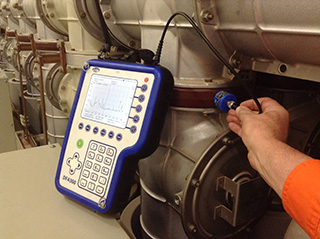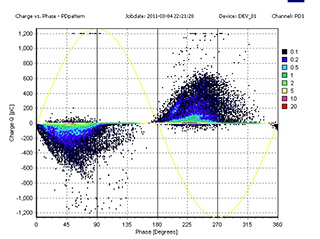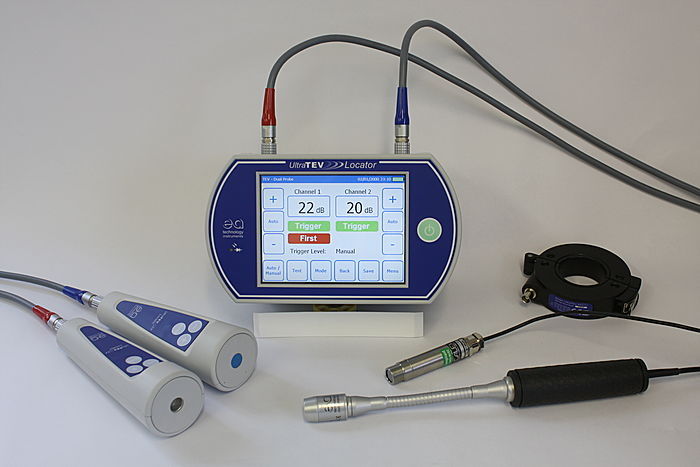
Partial Discharge Testing
Introduction
Electrical systems are among the most valuable assets in your plant and can have the biggest impact on your bottom line. Their production and management cost is high and failures almost always lead to catastrophic losses. Electrical systems are being operated at higher levels, even while systems are aging – which affects both the life and the reliability of assets.
Today’s Asset Managers are facing the increased challenge of maximizing their aging electrical infrastructure with fewer qualified technical in-house resources, stricter regulatory requirements for worker safety, and shrinking maintenance budgets. Advances in technology, including the use of Partial Discharge Testing, are giving Asset Managers new approaches to achieve improved reliability and performance of critical electrical assets.


What is Partial Discharge?
Partial discharges are generally a result of local electrical stress concentrations in the insulation or on the surface of the insulation and are often accompanied by the emission of sound, light, heat, or chemical reactions. Partial discharges are small electrical sparks that occur within the insulation of medium and high voltage electrical assets. These discharges erode insulation and eventually result in insulation failure.
Partial Discharge types include:
Void in solid insulation
Cavity in liquid
Electrical tree (void) around a sharp point
Electrical floating potential
Surface discharge
Corona
Data obtained through Partial Discharge Testing and Monitoring can provide critical information on the quality of insulation and its impact on overall equipment health. Because partial discharge activity is often present well in advance of insulation failure, Asset Managers can monitor it over time and make informed strategic decisions regarding the repair or replacement of the equipment. These predictive diagnostics help companies to prioritise capital and MRO investments before an unexpected outage occurs. Partial discharge testing results can help predict future performance and reliability of critical assets, including:
Cables, splices and terminations
Power transformers and bushings
Switchgear
Motors and generators
Failures are not limited to service aged equipment. Acceptance testing on newly-installed equipment builds-in reliability right from start-up. Acceptance testing can:
Verify original manufacturers test data and identify damaged insulation that occurred from improper transportation/installation, poor design, and/or poor workmanship during or after installation.
Identify premature failures and capture baseline data to trend asset health over the asset’s life cycle to ensure maximum ROI.
How can Partial Discharge be measured?
A partial discharge pulse is a current or voltage pulse that results from a partial discharge occurring within the object under test. The pulse is measured using suitable detector circuits, which have been introduced into the test circuit for the purpose of the test. (Based on IEC 60270)
Online Partial Discharge Testing
Online testing is performed while the equipment is energized at normal operating voltages. The testing is conducted during real operating conditions, under typical temperature, voltage stresses, and vibration levels. It is a non-destructive test (NDT) and does not use over voltages that could adversely affect the equipment. Online Partial Discharge Testing is relatively inexpensive compared to offline testing that requires interruption of service and production. For critical facilities that operate 24/7, this is the best solution for identifying insulation condition.

Permanently Mounted Sensors
For hard-to-access areas or areas that pose a safety concern, you can use permanently mounted sensors for periodic online PD detection. These sensors remain on the equipment for online access and diagnostic information. Often, these sensors must be installed during an outage or plant downtime. Once installed, no further outage or disruptions are required for online testing.
The Benefits of On-Line Partial Discharge Field Measurements
It is truly a predictive test, indicating insulation degradation in advance of the failure
It is a non-intrusive test, requiring no interruption of service and is performed under normal operating voltage and load
It is a non-destructive test: it does not test to failure or adversely affect the equipment under test
It need not use any overvoltage, thereby not exposing the tested equipment to higher voltage stresses than those encountered under normal operating conditions
Trending can be accomplished by storing results to allow comparison with future tests
In many instances the site of partial discharge occurrence can be located within the test object, so that the localized problem can be repaired
The cost to perform a PD survey is relatively inexpensive compared with off-line testing, allowing annual surveys to be performed economically at most facilities
Offline Partial Discharge Testing
Offline Partial Discharge Testing offers significant advantage over other technologies because of its ability to measure the cable system’s response to a specific stress level and predict its future performance without causing a fault. Offline testing is also known for its ability to pinpoint the exact defect location on field-aged equipment, enabling the Asset Manager to accurately plan for maintenance repair. The challenge with offline testing is that the equipment must be taken offline and out of service. Offline testing is also commonly used in acceptance testing on newly installed cables.
Conclusion
The partial discharge measurement is a suitable method to detect and localize imperfections in the high voltage insulation system and provides a procedure for quality assurance of electrical equipment.
Introduction
Electrical systems are among the most valuable assets in your plant and can have the biggest impact on your bottom line. Their production and management cost is high and failures almost always lead to catastrophic losses. Electrical systems are being operated at higher levels, even while systems are aging – which affects both the life and the reliability of assets.
Today’s Asset Managers are facing the increased challenge of maximizing their aging electrical infrastructure with fewer qualified technical in-house resources, stricter regulatory requirements for worker safety, and shrinking maintenance budgets. Advances in technology, including the use of Partial Discharge Testing, are giving Asset Managers new approaches to achieve improved reliability and performance of critical electrical assets.


What is Partial Discharge?
Partial discharges are generally a result of local electrical stress concentrations in the insulation or on the surface of the insulation and are often accompanied by the emission of sound, light, heat, or chemical reactions. Partial discharges are small electrical sparks that occur within the insulation of medium and high voltage electrical assets. These discharges erode insulation and eventually result in insulation failure.
Partial Discharge types include:
Void in solid insulation
Cavity in liquid
Electrical tree (void) around a sharp point
Electrical floating potential
Surface discharge
Corona
Data obtained through Partial Discharge Testing and Monitoring can provide critical information on the quality of insulation and its impact on overall equipment health. Because partial discharge activity is often present well in advance of insulation failure, Asset Managers can monitor it over time and make informed strategic decisions regarding the repair or replacement of the equipment. These predictive diagnostics help companies to prioritise capital and MRO investments before an unexpected outage occurs. Partial discharge testing results can help predict future performance and reliability of critical assets, including:
Cables, splices and terminations
Power transformers and bushings
Switchgear
Motors and generators
Failures are not limited to service aged equipment. Acceptance testing on newly-installed equipment builds-in reliability right from start-up. Acceptance testing can:
Verify original manufacturers test data and identify damaged insulation that occurred from improper transportation/installation, poor design, and/or poor workmanship during or after installation.
Identify premature failures and capture baseline data to trend asset health over the asset’s life cycle to ensure maximum ROI.
How can Partial Discharge be measured?
A partial discharge pulse is a current or voltage pulse that results from a partial discharge occurring within the object under test. The pulse is measured using suitable detector circuits, which have been introduced into the test circuit for the purpose of the test. (Based on IEC 60270)
Online Partial Discharge Testing
Online testing is performed while the equipment is energized at normal operating voltages. The testing is conducted during real operating conditions, under typical temperature, voltage stresses, and vibration levels. It is a non-destructive test (NDT) and does not use over voltages that could adversely affect the equipment. Online Partial Discharge Testing is relatively inexpensive compared to offline testing that requires interruption of service and production. For critical facilities that operate 24/7, this is the best solution for identifying insulation condition.

Permanently Mounted Sensors
For hard-to-access areas or areas that pose a safety concern, you can use permanently mounted sensors for periodic online PD detection. These sensors remain on the equipment for online access and diagnostic information. Often, these sensors must be installed during an outage or plant downtime. Once installed, no further outage or disruptions are required for online testing.
The Benefits of On-Line Partial Discharge Field Measurements
It is truly a predictive test, indicating insulation degradation in advance of the failure
It is a non-intrusive test, requiring no interruption of service and is performed under normal operating voltage and load
It is a non-destructive test: it does not test to failure or adversely affect the equipment under test
It need not use any overvoltage, thereby not exposing the tested equipment to higher voltage stresses than those encountered under normal operating conditions
Trending can be accomplished by storing results to allow comparison with future tests
In many instances the site of partial discharge occurrence can be located within the test object, so that the localized problem can be repaired
The cost to perform a PD survey is relatively inexpensive compared with off-line testing, allowing annual surveys to be performed economically at most facilities
Offline Partial Discharge Testing
Offline Partial Discharge Testing offers significant advantage over other technologies because of its ability to measure the cable system’s response to a specific stress level and predict its future performance without causing a fault. Offline testing is also known for its ability to pinpoint the exact defect location on field-aged equipment, enabling the Asset Manager to accurately plan for maintenance repair. The challenge with offline testing is that the equipment must be taken offline and out of service. Offline testing is also commonly used in acceptance testing on newly installed cables.
Conclusion
The partial discharge measurement is a suitable method to detect and localize imperfections in the high voltage insulation system and provides a procedure for quality assurance of electrical equipment.




